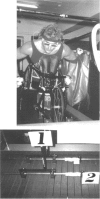Abstract
OBJECTIVE: Wheelchair athletes often select a percentage of their top speed (%TS) to determine training intensity. The aim of the study was to determine whether choosing a %TS corresponds to the physiological concept of relative exercise intensity (% peak oxygen uptake: %VO2 peak) and to examine selected physiological and metabolic responses of a group of wheelchair athletes to 60 minutes' exercise at 80% TS. METHODS: 12 male wheelchair athletes (10 paraplegics and two tetraplegics) performed a series of tests on a motorised treadmill adapted for wheelchairs. The tests, which were undertaken on separate occasions, included the determination of VO2 peak, the determination of oxygen cost at a range of submaximal wheelchair propulsion speeds, and a 60 min exercise test at 80% TS. RESULTS: Wheelchair propulsion speeds equivalent to 60%, 70%, 80%, and 90% of each subject's TS were found to equate to 48.3 (SD13.8)%, 60.0(11.1)%, 70.6(9.8)%, and 82.7(9.6)% of VO2 peak, with a wide variation in the relative exercise intensities evident at each %TS. During the 1 h exercise test at 80% TS the physiological and metabolic responses measured were indicative of steady state exercise, with no signs of fatigue evident. CONCLUSIONS: The results of this study suggest that selecting a %TS is not an appropriate way of selecting a common relative exercise intensity. There may also be a need for the current training practises of some wheelchair road racers to be modified.
Full text
PDF




Images in this article
Selected References
These references are in PubMed. This may not be the complete list of references from this article.
- Camus G., Atchou G., Bruckner J. C., Giezendanner D., di Prampero P. E. Slow upward drift of VO2 during constant-load cycling in untrained subjects. Eur J Appl Physiol Occup Physiol. 1988;58(1-2):197–202. doi: 10.1007/BF00636626. [DOI] [PubMed] [Google Scholar]
- Casaburi R., Storer T. W., Ben-Dov I., Wasserman K. Effect of endurance training on possible determinants of VO2 during heavy exercise. J Appl Physiol (1985) 1987 Jan;62(1):199–207. doi: 10.1152/jappl.1987.62.1.199. [DOI] [PubMed] [Google Scholar]
- Costill D. L. Metabolic responses during distance running. J Appl Physiol. 1970 Mar;28(3):251–255. doi: 10.1152/jappl.1970.28.3.251. [DOI] [PubMed] [Google Scholar]
- Ekelund L. G. Circulatory and respiratory adaptation during prolonged exercise of moderate intensity in the sitting position. Acta Physiol Scand. 1967 Apr;69(4):327–340. doi: 10.1111/j.1748-1716.1967.tb03529.x. [DOI] [PubMed] [Google Scholar]
- Eriksson P., Löfström L., Ekblom B. Aerobic power during maximal exercise in untrained and well-trained persons with quadriplegia and paraplegia. Scand J Rehabil Med. 1988;20(4):141–147. [PubMed] [Google Scholar]
- Felig P., Wahren J. Fuel homeostasis in exercise. N Engl J Med. 1975 Nov 20;293(21):1078–1084. doi: 10.1056/NEJM197511202932107. [DOI] [PubMed] [Google Scholar]
- Gass G. C., Camp E. M., Davis H. A., Eager D., Grout L. The effects of prolonged exercise on spinally injured subjects. Med Sci Sports Exerc. 1981;13(5):277–283. [PubMed] [Google Scholar]
- Gass G. C., Camp E. M. Effects of prolonged exercise in highly trained traumatic paraplegic men. J Appl Physiol (1985) 1987 Nov;63(5):1846–1852. doi: 10.1152/jappl.1987.63.5.1846. [DOI] [PubMed] [Google Scholar]
- Gass G. C., Camp E. M. Physiological characteristics of trained Australian paraplegic and tetraplegic subjects. Med Sci Sports. 1979 Fall;11(3):256–259. [PubMed] [Google Scholar]
- Glaser R. M. Exercise and locomotion for the spinal cord injured. Exerc Sport Sci Rev. 1985;13:263–303. [PubMed] [Google Scholar]
- Hagberg J. M., Mullin J. P., Nagle F. J. Oxygen consumption during constant-load exercise. J Appl Physiol Respir Environ Exerc Physiol. 1978 Sep;45(3):381–384. doi: 10.1152/jappl.1978.45.3.381. [DOI] [PubMed] [Google Scholar]
- Hardman A. E., Williams C. Exercise metabolism in runners. Br J Sports Med. 1983 Jun;17(2):96–101. doi: 10.1136/bjsm.17.2.96. [DOI] [PMC free article] [PubMed] [Google Scholar]
- Hartley L. H. Central circulatory function during prolonged exercise. Ann N Y Acad Sci. 1977;301:189–194. doi: 10.1111/j.1749-6632.1977.tb38198.x. [DOI] [PubMed] [Google Scholar]
- Knutsson E., Lewenhaupt-Olsson E., Thorsen M. Physical work capacity and physical conditioning in paraplegic patients. Paraplegia. 1973 Nov;11(3):205–216. doi: 10.1038/sc.1973.28. [DOI] [PubMed] [Google Scholar]
- Lakomy H. K., Campbell I., Williams C. Treadmill performance and selected physiological characteristics of wheelchair athletes. Br J Sports Med. 1987 Sep;21(3):130–133. doi: 10.1136/bjsm.21.3.130. [DOI] [PMC free article] [PubMed] [Google Scholar]
- Maughan R. J. A simple, rapid method for the determination of glucose, lactate, pyruvate, alanine, 3-hydroxybutyrate and acetoacetate on a single 20-mul blood sample. Clin Chim Acta. 1982 Jul 1;122(2):231–240. doi: 10.1016/0009-8981(82)90282-0. [DOI] [PubMed] [Google Scholar]
- Pimental N. A., Sawka M. N., Billings D. S., Trad L. A. Physiological responses to prolonged upper-body exercise. Med Sci Sports Exerc. 1984 Aug;16(4):360–365. [PubMed] [Google Scholar]
- Ramsbottom R., Williams C., Boobis L., Freeman W. Aerobic fitness and running performance of male and female recreational runners. J Sports Sci. 1989 Spring;7(1):9–20. doi: 10.1080/02640418908729818. [DOI] [PubMed] [Google Scholar]
- Rowell L. B., Kraning K. K., 2nd, Evans T. O., Kennedy J. W., Blackmon J. R., Kusumi F. Splanchnic removal of lactate and pyruvate during prolonged exercise in man. J Appl Physiol. 1966 Nov;21(6):1773–1783. doi: 10.1152/jappl.1966.21.6.1773. [DOI] [PubMed] [Google Scholar]
- Skrinar G. S., Evans W. J., Ornstein L. J., Brown D. A. Glycogen utilization in wheelchair-dependent athletes. Int J Sports Med. 1982 Nov;3(4):215–219. doi: 10.1055/s-2008-1026090. [DOI] [PubMed] [Google Scholar]
- Smith E. E., Guyton A. C., Manning R. D., White R. J. Integrated mechanisms of cardiovascular response and control during exercise in the normal human. Prog Cardiovasc Dis. 1976 May-Jun;18(6):421–444. doi: 10.1016/0033-0620(76)90010-4. [DOI] [PubMed] [Google Scholar]
- Wicks J. R., Oldridge N. B., Cameron B. J., Jones N. L. Arm cranking and wheelchair ergometry in elite spinal cord-injured athletes. Med Sci Sports Exerc. 1983;15(3):224–231. [PubMed] [Google Scholar]
- Williams C., Nute M. L. Some physiological demands of a half-marathon race on recreational runners. Br J Sports Med. 1983 Sep;17(3):152–161. doi: 10.1136/bjsm.17.3.152. [DOI] [PMC free article] [PubMed] [Google Scholar]



